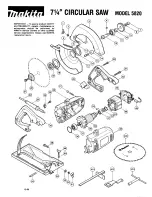
GB
- 28 -
6.8 Changing the rubber tires on the blade
pulleys (Figure 15)
After a certain time the rubber tires (3) on the bla-
de pulleys (7/8) will get worn by the sharp teeth of
the blades and must be replaced.
•
Open the side cover (12).
•
Remove the blade (26) (see 6.7).
•
Lift the edge of the tire (3) with a small
screwdriver (Z) and remove from the blade
pulley (8).
•
Repeat for the lower blade pulley (7).
•
Fit the new tire (3), replace the blade (26) and
close the side cover (12).
6.9 Changing the table insert (Figure 16)
To prevent increased likelihood of injury the table
insert (17) should be changed whenever it is worn
or damaged.
•
Detach the table (15) (see 6.1).
•
Lift out the worn table insert (17).
•
Fit the replacement table insert by following
the above in reverse.
6.10 Extractor sockets (
fi
g. 2)
The bandsaw is equipped with extractor sockets
(6) for extracting sawdust and chips.
6.11 Push stick holder (Fig. 6)
•
When not in use, the push stick must always
be kept on the holder.
7. Control elements
7.1 On/O
ff
switch (Figure 17)
•
To turn the machine on, press the green but-
ton „1“.
•
To turn the machine off again, press the red
button „0“.
•
Your bandsaw has a switch with undervoltage
release. After a power failure you must re-
activate the switch.
7.2 Parallel stop (Figure 18a, 18b)
•
Push the clip (21) on the parallel stop (24)
upwards.
•
Move the parallel stop (24) along the table
(15), from either the right or left of the blade
(26), and position as required.
•
Press down the clamp lever (21) to secure
the parallel stop (24). If the clamping force of
the clamp lever (21) does not give enough
hold, turn the clamp lever (21) several turns
in clockwise direction until the parallel stop is
secured tightly enough.
•
You must always ensure that the parallel stop
(24) is positioned parallel to the blade (26).
•
The parallel stop can be set in a high position
(Fig. 18a) or low position (Fig. 18b) depen-
ding on the height of the workpiece.
7.3 Angular cuts (Abb. 2, 19)
To enable you to perform angular cuts parallel
to the blade (26), the table (15) can be tilted for-
wards between 0° - 45°.
•
Undo the fixing handles (18).
•
Tilt the saw table (15) forwards until the requi-
red angle value is set on the dial scale (16).
•
Re-tighten the fixing handles (18).
•
Important: When the table (15) is tilted, place
the parallel stop (24) to the right of the blade
(26) looking in the direction in which you are
working, on the side pointing downwards
(provided the workpiece is wide enough) in
order to stop the workpiece from slipping off.
8. Operation
Caution!
After every new adjustment we recom-
mend you to make a trial cut in order to check the
new settings.
•
For all cutting operations it is important to
position the blade guide (11) as close as pos-
sible to the workpiece (see 6.5).
•
Always guide the workpiece with both hands,
holding it flat on the table (15) in order to pre-
vent the blade (26) from jamming.
•
Feed the workpiece at a uniform speed that
enables the blade to cut through the material
without difficulty and without blocking.
•
Always use the parallel stop (24) on all cuts
for which they are intended.
•
Always aim at making a complete cut in one
pass rather than in a stop-and-go operation
requiring the workpiece to be withdrawn. If
you have to withdraw the workpiece, switch
off the bandsaw first and wait for the blade
(26) to stop before freeing the workpiece.
•
The workpiece must always be guided by the
longer side during cutting.
8.1 Longitudinal cuts (Figure 20)
Longitudinal cutting is when you use the saw to
cut along the grain of the wood.
•
Place the parallel stop (24) to the left of the
blade (25), as far as possible, for the width
required.
Anl_TC_SB_305_U_SPK9.indb 28
Anl_TC_SB_305_U_SPK9.indb 28
08.05.2017 09:05:41
08.05.2017 09:05:41
















































